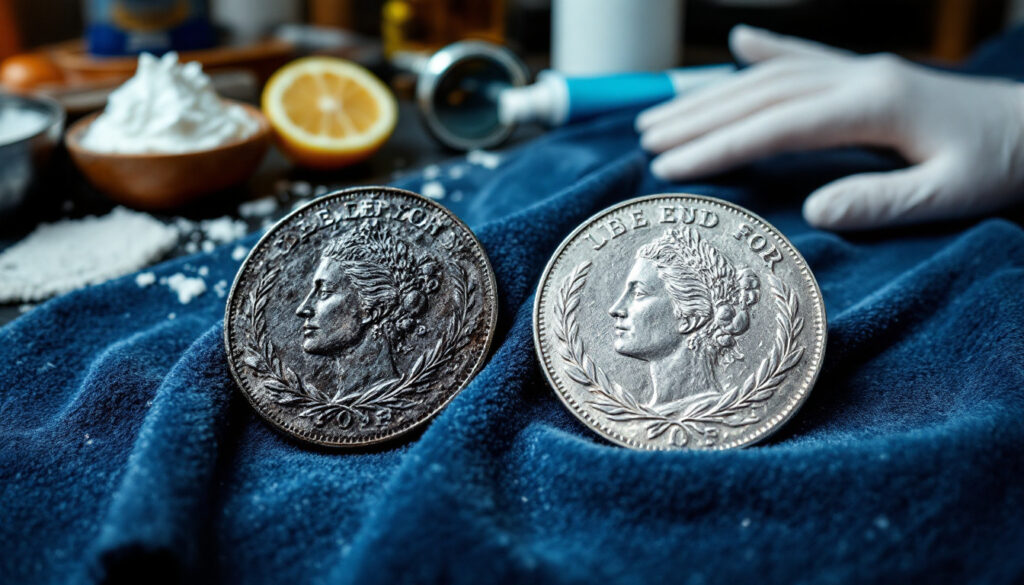Why Cleaning Silver Coins Is Controversial
The Numismatic Perspective on Cleaning
Coin collectors generally prefer natural patina (tarnish) on silver coins, especially when it has developed an eye-appealing color. This preference isn't merely aesthetic—it's deeply rooted in numismatic principles of preservation and authenticity. The patina represents a coin's journey through time, telling its unique story of environmental exposure and handling.
Professional numismatists follow the strict rule: "Do not clean your coins, period." This hardline stance stems from decades of observing the irreversible damage that cleaning causes to historical artifacts. Even the gentlest cleaning methods alter a coin's surface in ways that expert eyes can immediately detect.
Cleaning impairs a coin's surface and appearance by removing the naturally formed patina that collectors value. Under magnification, cleaned coins reveal microscopic scratches that permanently compromise the coin's original finish. Unlike natural wear that occurs over decades, these cleaning marks appear unnatural and significantly detract from a coin's appeal to serious collectors.
The Value Impact of Cleaning
The financial consequences of cleaning silver coins are severe and quantifiable. Cleaned coins typically suffer a 20-30% decrease in numismatic premium compared to their uncleaned counterparts. This dramatic reduction affects even common date silver dollars and half dollars that might otherwise command a modest premium over their silver content.
Harsh, abrasive cleanings can cut the premium by more than half, transforming what might have been a $200 coin into one worth barely $100. In extreme cases, particularly with rare dates or better-condition pieces, the value loss can be exponentially greater.
Many cleaned silver coins lose virtually all numismatic value, trading only for their bullion content—their intrinsic silver value. A classic example is the Morgan Silver Dollar, which might be worth $50-100 in circulated but original condition, yet commands only its silver value of approximately $20 when harshly cleaned.
Improperly cleaned coins often cannot receive official grades from professional grading services like NGC or PCGS, which further diminishes their marketability and value. These services typically designate cleaned coins as "details grade" or "impaired," explicitly noting the damage on their holders.
Is Professional Conservation Different from Cleaning?
When Professional Help Is Needed
For coins with significant stains or surface imperfections, professional conservation may be appropriate under specific circumstances. Unlike amateur cleaning, conservation aims to stabilize a coin's condition rather than artificially enhance its appearance.
Professional third-party coin grading services offer conservation and restoration services performed by trained experts. These specialists understand metallurgy, chemistry, and historical preservation techniques that go far beyond household cleaning methods.
These services use specialized techniques not available to the general public, including controlled chemical treatments, ultrasonic cleaning at specific frequencies, and treatments under vacuum conditions. These methods are calibrated to address specific issues without causing further damage.
Professional conservation aims to preserve rather than alter the coin's appearance, focusing on neutralizing harmful compounds or stabilizing active corrosion. The goal is always minimally invasive intervention that respects the coin's historical integrity.
The Difference Between Conservation and Cleaning
Conservation seeks to stabilize and protect the coin from further deterioration, preserving its existing characteristics rather than attempting to "improve" them. This philosophy aligns with museum-standard preservation practices for historical artifacts.
Cleaning, by contrast, attempts to make a coin look "better" or "newer" by removing patina or discoloration. This approach fundamentally misunderstands the numismatic value of original surfaces and natural aging.
Professional conservators understand metallurgy and chemical interactions at a molecular level. They can identify specific compounds affecting a coin and target them without disturbing stable patina or original surfaces.
DIY cleaning risks permanent damage to valuable numismatic items through inappropriate chemicals, abrasive substances, or improper techniques. The difference in approach and outcome between conservation and cleaning is similar to the difference between surgery performed by a doctor versus a well-intentioned amateur.
What Are Common Silver Coin Cleaning Methods?
Baking Soda Method
Baking soda is one of the most abrasive cleaning mediums commonly used on silver coins, despite its reputation as a "gentle" cleaner. The sodium bicarbonate crystals act as microscopic sandpaper against delicate silver surfaces.
Effective at removing tarnish but potentially damaging, baking soda works by physically abrading the surface layer of silver, taking both tarnish and a thin layer of the original metal with it. Under magnification, the resulting surface shows thousands of minute scratches.
Application: Mix with water to create a stiff paste that can be worked into the coin's surface. The consistency should be similar to toothpaste—just thick enough to adhere to the coin without running off.
Technique: Rub paste into coin surface and crevices by hand, typically using fingers or a soft cloth. This mechanical action is what removes the tarnish, but also what causes damage to the underlying silver.
Finish: Rinse with tepid water and pat dry with soft cloth. Water temperature matters—hot water can cause thermal shock to silver, while cold water may not fully remove the baking soda residue.
Warning: Highly abrasive and can leave permanent scratches that are immediately apparent to knowledgeable collectors and dealers. These scratches cannot be removed and permanently reduce both the aesthetic appeal and market value of the coin.
Toothpaste Technique
Slightly less abrasive than baking soda but still damaging, toothpaste contains mild abrasives designed to polish tooth enamel—a substance much harder than silver. When applied to silver coins, these abrasives create fine scratches that dull the natural luster.
Ready to use with no mixing required, toothpaste's convenience makes it a common choice for inexperienced collectors. However, different toothpaste formulations contain varying levels of abrasives, making results unpredictable.
Application: Apply directly to coin surface in a thin, even layer. Non-gel formulations typically work more effectively due to their higher abrasive content.
Technique: Rub until tarnish or dirt is removed, usually requiring circular motions with moderate pressure. This motion creates characteristic swirl marks that experts can easily identify.
Finish: Rinse clean and pat dry with soft cloth, ensuring no residue remains in recessed areas. Toothpaste often contains foaming agents that can be difficult to fully remove from design details.
Warning: Contains abrasives that scratch coin surfaces permanently. Additionally, many modern toothpastes contain whitening agents and chemicals that can react negatively with silver, causing spots or uneven tone.
Lemon Juice Approach
Chemically acidic rather than physically abrasive, lemon juice (citric acid) dissolves tarnish through chemical reaction rather than mechanical abrasion. This method may seem gentler but actually causes different types of damage.
Application: Use as a bath in a non-corrosive vessel such as glass or ceramic. Plastic containers may leach chemicals that react with the acid and silver, causing additional problems.
Technique: Soak coin for a few minutes between rinses, allowing the acid to dissolve the tarnish layer. Soaking times longer than 5 minutes significantly increase the risk of excessive metal loss.
Enhanced version: Sometimes mixed with salt or baking soda to accelerate the chemical reaction. Salt (sodium chloride) particularly increases the solution's conductivity, speeding up the reaction but also increasing potential damage.
Warning: Acid eats away a thin outer layer of metal from the coin, permanently altering its surface characteristics. Numismatists can identify acid-cleaned coins by their bright, unnaturally uniform appearance and lack of natural luster.
White Vinegar Solution
Acidic cleaning agent commonly found in kitchens, white vinegar (acetic acid) works through similar chemical principles as lemon juice but with slightly less aggressive action. It still removes both tarnish and a layer of the coin's surface.
Application: Use as a bath for silver coins, typically requiring longer soaking times than lemon juice due to its lower acidity (typically pH 2.4 versus lemon juice's pH 2.0).
Enhanced version: Sometimes mixed with baking soda (creates bubbling reaction) that helps loosen dirt through the formation of carbon dioxide bubbles. This bubbling action mechanically dislodges particles from the coin's surface.
Warning: Acidic medium eats away at the metal on the coin, removing not just tarnish but also original surface details and mint luster. The resulting appearance is often flat and lifeless compared to the dimensional qualities of an uncleaned coin.
Caution: Mixing with baking soda creates a bubbly carbon-dioxide reaction that neutralizes the acid, potentially rendering the cleaning less effective while still damaging the coin's surface through abrasion from the baking soda.
Silver Dip Products
Commercial products specifically designed for silver cleaning often contain thiourea or similar chemicals that chemically dissolve tarnish. These products work by converting silver sulfide (tarnish) back into elemental silver.
Considered somewhat less abrasive than DIY methods by some collectors, silver dips still alter a coin's surface by removing the natural patina that develops over decades or centuries.
Application: Follow manufacturer's instructions carefully, typically involving brief immersion followed by thorough rinsing. Even a few seconds of over-exposure can cause significant damage to the coin's surface.
Warning: Can still be caustic and/or abrasive, particularly on coins with existing surface issues or mixed-metal content. Many older silver coins contain small amounts of copper that can react differently to these chemicals.
Risk: May give coins a falsely bright appearance, rendering them uncollectible to knowledgeable numismatists. This artificially bright surface, often called "dipped," lacks the subtle toning and luster variations that contribute to a coin's character and appeal.
What Are The Risks of DIY Coin Cleaning?
Physical Damage to Coins
Abrasive methods create microscopic scratches that permanently alter the coin's surface. Under magnification, these scratches appear as parallel lines or swirl patterns that would never occur through natural circulation wear.
Acidic solutions remove thin layers of the coin's surface, effectively erasing mint-made characteristics including luster, flow lines, and the finest details of the design. This layer, once removed, cannot be restored or replaced.
Cleaning alters the coin's natural patina, which collectors value not only for its aesthetic qualities but as evidence of the coin's authenticity and undisturbed history. This patina develops over decades through natural chemical processes that create unique color patterns.
Once damaged, a coin's surface cannot be restored to its original state. Unlike other collectibles that might be restored, the metal removed during cleaning is permanently lost, making the damage irreversible even by the most skilled professionals.
Impact on Collectible Value
Professional dealers can easily identify cleaned coins through visual inspection, often without magnification. The unnatural brightness, lack of proper luster, and presence of cleaning marks are immediate red flags to experienced eyes.
Cleaned coins are less desirable in the numismatic market, often requiring significant discounts to sell. Auction records consistently show that cleaned coins realize 20-30% less than comparable uncleaned examples.
Value reduction of 20-30% is common for cleaned coins with moderate numismatic value, with premium coins suffering even greater percentage losses. For example, a rare-date Morgan dollar might lose $500 in value when cleaned, while a common date might lose only $15-20.
Some cleaning methods render coins virtually worthless to collectors, particularly harsh abrasives or acidic baths that significantly alter the coin's surface. These coins often trade at or near their metal value, regardless of date, mint mark, or original condition.
Chemical Reactions and Long-term Effects
Cleaning agents may continue to react with the silver over time, particularly if not thoroughly rinsed. Residual chemicals trapped in recessed areas can cause spotting or discoloration months or years after cleaning.
Residual chemicals can cause discoloration or spotting that appears gradually as the silver continues to react with traces of cleaning compounds. These spots typically appear as dark patches that cannot be removed without further damage.
Some cleaning methods accelerate future tarnishing by creating microscopic pits that provide more surface area for oxidation. A coin that previously took decades to develop tarnish might show new discoloration within months after cleaning.
Improper rinsing can leave harmful residues on the coin that continue to damage the metal over time. This is particularly problematic with commercial silver dips, which contain chemical compounds designed to remain active until neutralized.
When Should You Consider Professional Conservation?
Identifying Candidates for Professional Help
Coins with significant historical or numismatic value may warrant professional attention when facing active deterioration. Particularly rare dates, high grades, or historically significant issues justify the expense of professional conservation.
Pieces suffering from active corrosion or environmental damage, such as PVC contamination (a green, sticky residue from improper storage), verdigris, or horn silver (silver chloride) formation require intervention to prevent irreversible damage.
Coins with potential under layers of dirt or tarnish that obscure the ability to properly attribute or grade the coin might benefit from expert assessment. This is particularly relevant for ancient coins or heavily encrusted specimens.
Valuable specimens that require expert handling include those showing signs of bronze disease (in copper components), active silver chloride formation, or environmental contamination that threatens the coin's stability.
Professional Conservation Services
Available through major third-party grading companies like NGC and PCGS, professional conservation services employ specialists with experience in numismatic preservation. These services typically operate separately from the grading departments.
Use specialized techniques and equipment including controlled chemical treatments, ultrasonic cleaning at specific frequencies, and vacuum techniques not available to collectors. These methods target specific contaminants while minimizing impact on original surfaces.
Employ trained conservators who understand metallurgy and can identify the specific compounds affecting a coin, allowing for targeted treatment rather than general cleaning. This expertise helps preserve original surfaces while addressing problematic conditions.
Provide documentation of the conservation process, often including before-and-after photographs and detailed treatment reports. This documentation helps maintain the coin's provenance and market value.
Cost vs. Benefit Analysis
Professional conservation services charge fees based on coin value, typically ranging from $20-30 for inexpensive coins to hundreds of dollars for rare specimens. This sliding scale reflects both the time required and the risk assumed by the conservation service.
Conservation can preserve or enhance value for significant coins facing active deterioration. For example, a coin suffering from bronze disease or PVC damage might lose all value without intervention but retain most of its value with proper conservation.
For common silver coins, conservation costs may exceed potential value increase, making it economically impractical. A common Morgan dollar worth $30-40 rarely justifies a $30 conservation fee unless facing active deterioration.
Consider the long-term investment potential before proceeding with conservation. Coins with strong collector demand and limited supply typically benefit most from professional conservation, while common issues may not see sufficient value recovery.
FAQ About Silver Coin Cleaning
Does cleaning always decrease a silver coin's value?
Yes, in almost all cases, cleaning reduces a coin's numismatic value. Even coins that appear "improved" to an untrained eye have suffered damage that experienced collectors and dealers can readily identify.
The reduction typically ranges from 20-30% to complete loss of premium, depending on the cleaning method's severity and the coin's initial value. Rare coins with significant numismatic premiums suffer the most in absolute dollar terms.
Even "safely" cleaned coins are less desirable to serious collectors, who prize original surfaces as evidence of authenticity and undisturbed condition. The gold market analysis consistently values original surfaces over cleaned ones, regardless of apparent cleanliness.
Professional dealers and grading services can easily identify cleaned coins through visual inspection, often without magnification. The unnatural brightness, altered luster patterns, and presence of microscopic scratches immediately reveal cleaning.
What's the difference between cleaning and conservation?
Cleaning attempts to make a coin look "better" or "newer" by removing tarnish and patina, often using abrasive or chemical methods that alter the coin's natural appearance. The focus is on aesthetic enhancement rather than preservation.
Conservation aims to stabilize and preserve a coin's current condition, addressing only active deterioration that threatens the coin's integrity. Professional conservators follow the principle of minimal intervention, preserving as much original surface as possible.
Cleaning is typically done by amateurs with household products like baking soda, toothpaste, or acids that cause irreversible damage to the coin's surface. These methods lack the precision and control needed to preserve numismatic value.
Conservation is performed by professionals with specialized training and equipment, using techniques developed specifically for numismatic preservation. For collectors interested in maintaining value, understanding these differences is as important as learning about gold ETFs strategies for investment portfolios.
Can I use ultrasonic cleaners on silver coins?
Ultrasonic cleaners are not recommended for coins with collector value as they can damage delicate surfaces and remove desirable patina. The high-frequency vibrations dislodge not only dirt but also any loosely adhered patina and can create micro-fractures in the metal.
They can damage delicate surfaces and remove desirable patina, leaving coins with an unnatural appearance that collectors immediately recognize as cleaned. The cavitation bubbles created by ultrasonic cleaners can penetrate microscopic cracks and enlarge them.
For bullion-only pieces, ultrasonic cleaning poses less risk to value since these items are traded primarily for their metal content rather than numismatic premium. However, even bullion coins may develop attractive toning that collectors value.
Professional conservation services may use specialized ultrasonic techniques in certain situations, carefully controlling frequency, power, and cleaning solution composition to address specific issues. These controlled applications bear little resemblance to consumer-grade ultrasonic cleaners.
How can I safely store silver coins to prevent tarnish?
Use coin capsules,
Looking to Invest in Precious Metal Discoveries?
Discover how significant mineral exploration announcements can transform your investment portfolio by visiting Discovery Alert's discoveries page at https://discoveryalert.com.au/discoveries/, where our proprietary Discovery IQ model delivers real-time alerts on major ASX discoveries before the market fully reacts.




